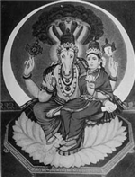 In around the year 2004, I made an arrangement with my dad, Sri KYL Narasimha Rao. I requested him to talk about any subject of his choice and that I will record his speeches. He picked topics on Vedic literarature and the importance of education. He is a treasure house of knowledge on varied subjects, especially English and Sanskrit literature. He is a gold medalist from Andhra University in M.A. English(1951). He is a great orator. It is an inspiration to listen to him talk about King Janaka and his assemblies, Manu Dharma Shastra and a number of other topics. So, every morning before the sunrise we both sat down, me with my laptop and a microphone and he with his post card sized reference material. He spoke and I recorded. This continued for days. Later on, all those wonderful speeches were converted into a valuable book as well as an MP3 CD titled ‘Veda Vijnanam’ in Telugu.
In around the year 2004, I made an arrangement with my dad, Sri KYL Narasimha Rao. I requested him to talk about any subject of his choice and that I will record his speeches. He picked topics on Vedic literarature and the importance of education. He is a treasure house of knowledge on varied subjects, especially English and Sanskrit literature. He is a gold medalist from Andhra University in M.A. English(1951). He is a great orator. It is an inspiration to listen to him talk about King Janaka and his assemblies, Manu Dharma Shastra and a number of other topics. So, every morning before the sunrise we both sat down, me with my laptop and a microphone and he with his post card sized reference material. He spoke and I recorded. This continued for days. Later on, all those wonderful speeches were converted into a valuable book as well as an MP3 CD titled ‘Veda Vijnanam’ in Telugu.
People with great knowledge invariably recognize and thoroughly respect the divinity behind that knowledge. Every time he started to speak, he chanted Hayagriva Mantra. I consider it a great privilege to initiate my articles on this site by making this wonderful Sanskrit verse the focus of my very first posting. This is my humble offering to Lord Hayagriva.
| jNaanAnaMdamayaM dEvaM nirmala sphaTikAkRutiM aadhAraM sarva vidhyAnAM hayagrIvaM upAsmahE Salutations to Lord Hayagreeva, |
This sloka is invoked at the time of initiating learning.
Meaning:
There are three important parts of this sloka.
- jNAnAnaMdamayaM: This word describes Lord Hayagriva as the one who is filled with the bliss(AnaMda) of all knowledge(jNana)
- nirmala sphaTikAkRutiM: These words describe the beauty of Lord Hayagriva as a fresh cut crystal whose brilliance never decays.
- aadhAraM sarva vidhyAnAM: These words describe Lord Hayagriva as the foundation of all education.
Source
The original source of this sloka is Pancharatra Agamas. Pancharatra Agamas is one of the four vaishnava agamas or devotional texts that prescribe icon worship. The other three being Vaikhanasa, Pratishthasara and Vijnana Lalita. Pancharatra maintains that the Lord manifests in five forms: Para, Vyuha, Vibhava, Antaryamin and Archa. In the archa manifestation, if an image(icon) is duly consecrated according to Pancharatra rites, the power of Vishnu descends into it. Remember this when you visit a Venkateswara temple or a Rama temple and take a bow at the deity – Lord Vishnu is seated in the deity. It is difficult to ascertain at this time where exactly this sloka is found in the Pancharatra Agamas.
Vedanta Desika is one of the most prominent vaishnavite writers. He compiled Hayagriva Stotram consisting of 34 slokas. Hayagriva Stotram begins with this sloka.
Avatar
According to the puranas there are 25 incarnations of Sri Maha Vishnu. Lord Hayagriva, the horse headed incarnation(haya means horse, griva means neck), is described as one of them. Sri Maha Vishnu incarnated as Lord Hayagriva to restore vedas from two demons Madhu and Kaitaba who stole them from Brahma. Once the vedas are restored, they are taught again to Brahma by the Lord himself. Hence it is considered very auspicious to invoke Lord Hayagriva at the time of beginning of one’s studies.
Additional References:

{ 4 comments… read them below or add one }
Nice read, very short and sweet and to the point. Sri KYL is a great man, tons of knowledge, i’m really proud to be his grandson.Now, i’ve to do something productive to live up to his name. heheh
I still remember his talk to EPOC in 1990. You must find a way to put his talks on the web, I would suggest videolectures.net, librivox or youtube. Invaluable voice of wisdom. Imagine the voices that we have lost due to absence of technology and reliance on smrithi ?
Namasthe,
I would like know the meaning and essence of the kriti, ‘DolayAm Cala’ of Sri Annamacarya.
Regards,
Niveditha
Namaste.
Thank You for that Shlokam on Hayagreeva; could you supply a devanagari version of it ? Thank You.
Chris